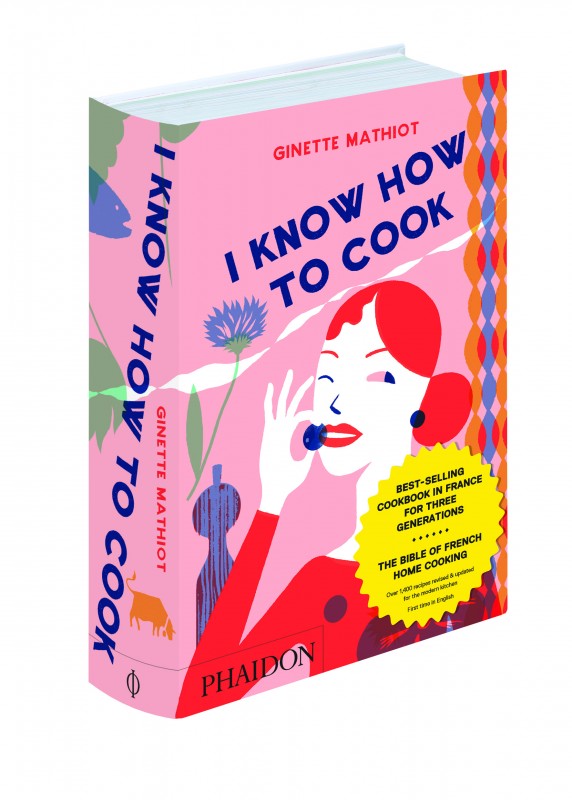I Know How to Cook

It’s a hefty book, weighing in at over five pounds, with nearly a thousand pages and more than 1,400 recipes, and for three generations, the original French version has been a well-thumbed fixture in kitchens all over France. I Know How to Cook is the first English-language edition of Je Sais Cuisiner, France’s first comprehensive cookbook, originally published in 1932. With an even heftier array of nearly 2,000 recipes, it was an immediate hit and remained for decades the bible of French home cooks. The author, Ginette Mathiot, was a 25-year-old home economics teacher; her defiant title was meant to show that, while French cuisine had long been considered a male domain, French femmes knew how to cook, too. Or could learn, with Mathiot’s help.
Today, when sales of Julia Child’s Mastering the Art of French Cooking have skyrocketed in the wake of the film Julie and Julia, it’s worth pointing out that, while the incomparable Julia did introduce Americans to French cooking, her recipes were based on restaurant cuisine—she had, after all, been trained at a professional school, the Cordon Bleu. But in French homes, Ginette was the cookbook queen.
Born in Paris in 1907 to a French Protestant family—her father was a minister—Mathiot was a brilliant student whose hopes of studying medicine were dashed by her family, who considered teaching a more appropriate profession for a woman. She ended up at the Sorbonne specializing in enseignement ménager—at the time home economics was a university-level discipline.
Mathiot eventually rose to an administrative position, but she was still a young teacher when she was hired by publisher Albin Michel to put together a cookbook that would include nutritional information—a novel idea. Enlisting her students to help test recipes, Mathiot delivered a comprehensive and authoritative cookbook with sections on cooking, baking and preserving. Its broad scope and the quality and simplicity of its recipes, as well as Mathiot’s no-nonsense voice, ensured its immediate success; the book went through many editions and had sold many millions of copies by the time its author died in 1998 at the age of 91.
For this English-language edition, Phaidon Press assembled a team of editors and cooks led by Clotilde Dusoulier, the food writer known for her popular blog at www.chocolateandzucchini.com, who had inherited her grandmother’s yellowed copy of Je Sais Cuisiner. Dusoulier and her team updated a large selection of the recipes for today’s cooks, expanding the instructions when necessary, reducing fat in some recipes and shortening cooking times in others. The new edition also added 200 lovely photographs.
As for the recipes, while the original was written with beginners in mind, these will interest cooks from novice to pro, since they range from simple dishes like a plain omelet or croque monsieur to impress-the-guests fare including lobster bisque, duck à l’orange and crêpes Suzette. Intrepid cooks will find organ meats from brains to kidneys, and there’s even a roast tenderloin of wild boar. Every French classic is covered—poulet rôti, daube de boeuf, coq au vin, cassoulet, moules marinière, tarte tatin—and it takes French cooking out of the special-occasion category and moves it effortlessly into the realm of what-shall-I-make-for-dinner-tonight?
Clear and simple, the recipes have a minimum of ingredients and instructions, and everything I’ve tried so far has been a winner. The boeuf bourguignon recipe, with very few steps, produced a marvelously rich beef stew that was even better the second day. Fennel bulbs braised with thyme were delicate and meltingly tender, while lentils with mustard packed a huge flavor wallop. Seduced by the simplicity of the Chocolate & Cream Cake—five ingredients, barely four lines of instructions—I baked a delicious single-layer chocolate cake that was put together—and disappeared—in record time. Alsatian tarte aux pommes was an irresistible creamy apple tart made with crème fraîche and a buttery crust, one of the many regional specialties in this gastronomical tour de France.
A section called Ginette’s Kitchen Advice includes rescues for such disasters as burned milk and curdled crème anglaise; you’ll also find suggestions for picnic foods, kitchen design and table settings, including this handy hint: “Cutlery is always laid with the fork’s tines and the hollow part of the spoon pointing upward, unless the cutlery is engraved with a monogram or coat of arms”.
The section on Planning Menus not only contains good advice on using seasonal ingredients, but also two pages of seasonal menus. Among the suggestions for winter: celery root salad, venison chasseur, Vichy carrots, apple fritters. There’s even a sampling of dishes that will add a festive French touch to holiday tables: consommé, oysters, foie gras in aspic, turkey with chestnut stuffing and, of course, the traditional Yule log cake, bûche de Noël.
I Know How to Cook
by Ginette Mathiot, Phaidon Press, 2009.
Originally published in the December 2009 issue of France Today.
Share to: Facebook Twitter LinkedIn Email



